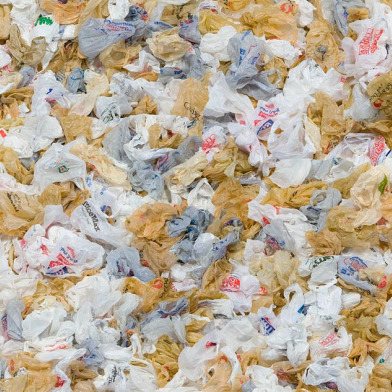 The mess of plastic in the Pacific Ocean known to many as the Great Pacific Garbage Patch is fodder for splashy headlines and useful scaring the kombucha out of environmentalist children. It’s also entirely fictitious, a spawn not of 21st-century consumerism but a combination of media hype, green guilt, and “confirmation bias.”
The mess of plastic in the Pacific Ocean known to many as the Great Pacific Garbage Patch is fodder for splashy headlines and useful scaring the kombucha out of environmentalist children. It’s also entirely fictitious, a spawn not of 21st-century consumerism but a combination of media hype, green guilt, and “confirmation bias.”
That’s the stance of the Save the Plastic Bag Coalition, which went on record against Supervisor Ross Mirkarimi’s scheme to extend San Francisco’s first-of-its-kind plastic bag ban in a big way.
The coalition, which includes plastic bag manufacturers like Crown Poly, fired off a lengthy report to the Board of Supervisors in which the notion of the Garbage Patch — as well as other popularly-held myths, like bags are made from petroleum (wrong: natural gas), greener than paper (wrong: paper emits methane) are dismissed as patent nonsense.
“The so-called “Great Pacific Garbage Patch,” which is alleged to be twice the size of Texas, does not exist,” wrote attorney Stephen Joseph, the coalition’s counsel, in a 25-page report (scroll through to page 97 of the PDF) in which Joseph cites scientific studies from the San Diego-based Scripps Institute of Oceanography, the Algalita Marine Research Foundation, and researchers from the University of Oregon as proof that the plastic patch is pure poppycock.
In an interview, Joseph — who in the early 2000s successfully sued food manufacturers to ban the use of trans-fats — notes that while there is certainly “some plastic” in the Pacific Ocean, he takes particular issue with claims repeated in media and by politicians.
“The LA Times claimed in an editorial that ‘The Great Pacific Garbage Patch is an area of the ocean larger than Texas and thick with floating plastic debris: bottles, bottle caps, bits of packaging and uncountable plastic bags.’ The statement is totally untrue,” Joseph told the Appeal. “You go and show me a photograph. Send me a photo — I’ll send you $100 if you can find one.”
In this, Joseph’s Benjamins are entirely safe. There are no photos of a great plastic island in the sea, and no images on Google Earth or anywhere else. This is in part because the same scientific sources cited above say that the plastic in the Pacific Ocean consists of tiny particles, often not visible from nearby boats.
“A majority of the debris observed in the ‘garbage patch’ is small plastic pieces,” the National Oceanic and Atmospheric Administration (NOAA) says on its Web site. “Small debris pieces are difficult to see due to their size, and many of these pieces may be suspended below the surface of the water, which would make them even harder to see, even with the human eye.”
The scientists cited by Joseph in his study appear to have more issue with the hyperbolic claims in the media in which the Garbage Patch‘s size is grossly overestimated. It appears that the patch is confused with the size of the North Pacific Ocean Gyre, the sequence of currents a thousand miles off the coast which cause “marine debris” — which is “mostly plastic,” the NOAA says — to congregate there.
Rather than a solid land mass, the plastic there resembles more of a “soup” of plastic particles and bits distributed throughout the water column, according to Algalita, which recommends consumers “try not to use “single use” products made of plastic, such as water bottles and plastic bags.”
A representative from Heal the Bay did not return a telephone message from the Appeal seeking comment.
The reason why environmentalists and legislators persist in furthering the myth of the patch is “confirmation bias,” opined Joseph. “People hear only what they want to hear — they take in only facts that support what they believed.”
“We agree with Scripps and Oregon State who actually went out there and reported the facts,” said Joseph, who has sued Marin County over its ban and pledged to sue San Francisco if the plans to strengthen Mirkarimi’s ban are approved. “It [the patch] is not actually garbage — it’s plastic particles. You can’t call that the Great Pacific Garbage Patch.”
While the plastic bag ban has the hallmark of oft-derided progressivism, former Mayor Gavin Newsom was a supporter of the original ban, and no less a moderate influence than the San Francisco Chamber of Commerce has pledged its support for extending Mirkarimi’s bag ban.
In a text message, Mirkarimi said the Save the Bag Coalition would “be more convincing if they had NASA or the US Navy on their side. Shameful that these huge petrol and plastics corporations are spending large sums of money to escape responsibility in dealing with all the blowback associated with their profit motive.”
To be fair, Joseph says the coalition is not in any way associated with the American petrochemical industry. Though to be fairer, Joseph declined to tell the Appeal exactly who was funding the coalition and declined to name any northern California-based coalition member, although a Heal the Bay member is also on board with the coalition, he said.
An estimated 4 billion plastic bags are produced every year, about five percent of which are recycled. So we hear, anyway.
Want more news, sent to your inbox every day? Then how about subscribing to our email newsletter? Here’s why we think you should. Come on, give it a try.









